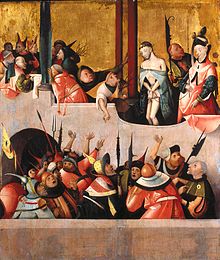
Ecce homo (/ˈɛksi ˈhoʊmoʊ/, Ecclesiastical Latin: [ˈettʃe ˈomo], Classical Latin: [ˈɛkkɛ ˈhɔmoː]; "behold the man") are the Latin words used by Pontius Pilate in the Vulgate translation of the Gospel of John, when he presents a scourged Jesus, bound and crowned with thorns, to a hostile crowd shortly before his crucifixion (John 19:5). The original New Testament Greek: "ἰδοὺ ὁ ἄνθρωπος", romanized: "idoù ho ánthropos", is rendered by most English Bible translations, e.g. the Douay-Rheims Bible and the King James Version, as "behold the man".[a] The scene has been widely depicted in Christian art.

A scene of the ecce homo is a standard component of cycles illustrating the Passion and life of Christ in art. It follows the stories of the Flagellation of Christ, the crowning with thorns and the mocking of Jesus, the last two often being combined:[b] The usual depiction shows Pilate and Jesus, a mocking crowd which may be rather large, and parts of the city of Jerusalem.
But, from the 15th century in the West, and much earlier in the art of the Eastern church, devotional pictures began to portray Jesus alone, in half or full figure with a purple robe, loincloth, crown of thorns and torture wounds, especially on his head, and later became referred to as images of the Ecce homo. Similar subjects but with the wounds of the crucifixion visible (Nail wounds on the limbs, spear wounds on the sides), are termed a Man of Sorrows (also Misericordia). If the instruments of the Passion are present, it may be called an Arma Christi. If Christ is sitting down (usually supporting himself with his hand on his thigh), it may be referred to it as Christ at rest or Pensive Christ. It is not always possible to distinguish these subjects.
- ^ Хальфан 2009; Rotem 2018.
- ^ Dreher 2017, p. 187.
Cite error: There are <ref group=lower-alpha> tags or {{efn}} templates on this page, but the references will not show without a {{reflist|group=lower-alpha}} template or {{notelist}} template (see the help page).